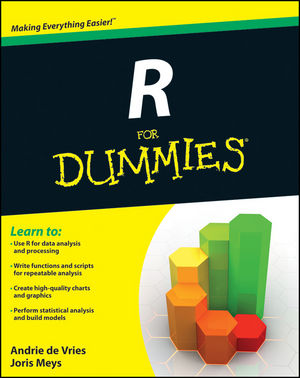The authors are Andrie de Vries and Joris Meys.
Executive summary
Pretty much all I’d hoped for — and I had high hopes.
Significance
The “Dummies” series is popular for introducing specific topics in an inviting way. R For Dummies is a worthy addition to the pack.
There is a competitor by the name of Statistical Analysis with Excel For Dummies. Now this may also be well-executed — it probably is — but some of us are of the opinion that the last two words of the title are redundant.
There are millions of people doing data analysis in spreadsheets, even though spreadsheets are dangerous. R For Dummies gives these people a reasonable entrance into the world of R where their analyses will be safer, faster and deeper — after an admittedly uncomfortable period of adjustment.
The world will be more productive on account of people switching from spreadsheets to R for data analysis. The problem is that hardly any spreadsheet users are aware that there is a more comfortable way of living than walking along a cliff edge. The cliff is invisible to them. Hopefully R For Dummies will help change that by making R a more obvious alternative.
Strengths
Chapter 19 is “Ten Things You Can Do in R That You Would’ve Done in Microsoft Excel”. They resisted the subtitle “And by the way, generally much easier too”.
Writing introductions to computer programs is astoundingly hard. A key problem is the curse of knowledge. Once we know something, we find it hard to imagine not knowing. So a writer who knows the program is not good, but a writer who doesn’t know the program is no use as a navigator. R For Dummies sails these stormy seas well, partly from the discipline of the “Dummies” template, partly from the skill of the authors. They are competent in R yet both relatively new converts.
The really important decisions when writing introductory documentation is what not to say. I think Andrie and Joris made very good selections for silence.
… you discover the power hidden behind the 18th letter of the alphabet.
Weaknesses
There are (at least) two major styles of learning. There are those (like me) who are perfectly happy to gather up detail after detail, and only eventually put the details into a big picture. There are others who need to see the big picture before they can pick up any details (and possibly revise the picture).
R For Dummies is probably closer to what the big-picture people need than any other R documentation I know, but I doubt it really fulfills the need. However, that is probably too much to ask. I think a separate (short) document is called for.
If you’re a big-picture learner, I’d be interested to hear what you think should go into such a document.
Cool things I didn’t know
clipboard
For Windows there is the writeClipboard function. Give it a character vector as an argument and those are put onto the clipboard:
> writeClipboard(head(letters))
# hit <return> then <control>v
> a
Error: object 'a' not found
> b
Error: object 'b' not found
> c
function (..., recursive = FALSE) .Primitive("c")
> d
Error: object 'd' not found
> e
Error: object 'e' not found
> f
Error: object 'f' not found
Of course the function is better used by pasting into other programs rather than pasting back into R.
multiple sorting
If you are using order to sort based on multiple items and you want some in increasing order and some decreasing, then there is the xtfrm function to help you.
Specifics
There is a companion post “Annotations for R For Dummies“ that has a number of specific comments on the book.


Hello
I am new to R, Can you pls share R for dummies.
Thanking you in anticipation.
Thanks
Abhay
Also pls share the comprehensive list of baiscs statistical method one should know before going for R analysis
Pingback: Annotations for “R For Dummies” | Portfolio Probe | Generate random portfolios. Fund management software by Burns Statistics
Pingback: Review of 'Advanced R' by Hadley Wickham - Burns Statistics
Este es un curso abierto a profesores y profesoras de todas y cada una de las áreas educativas y orientadores de la etapa de Secundaria interesados en el tema.